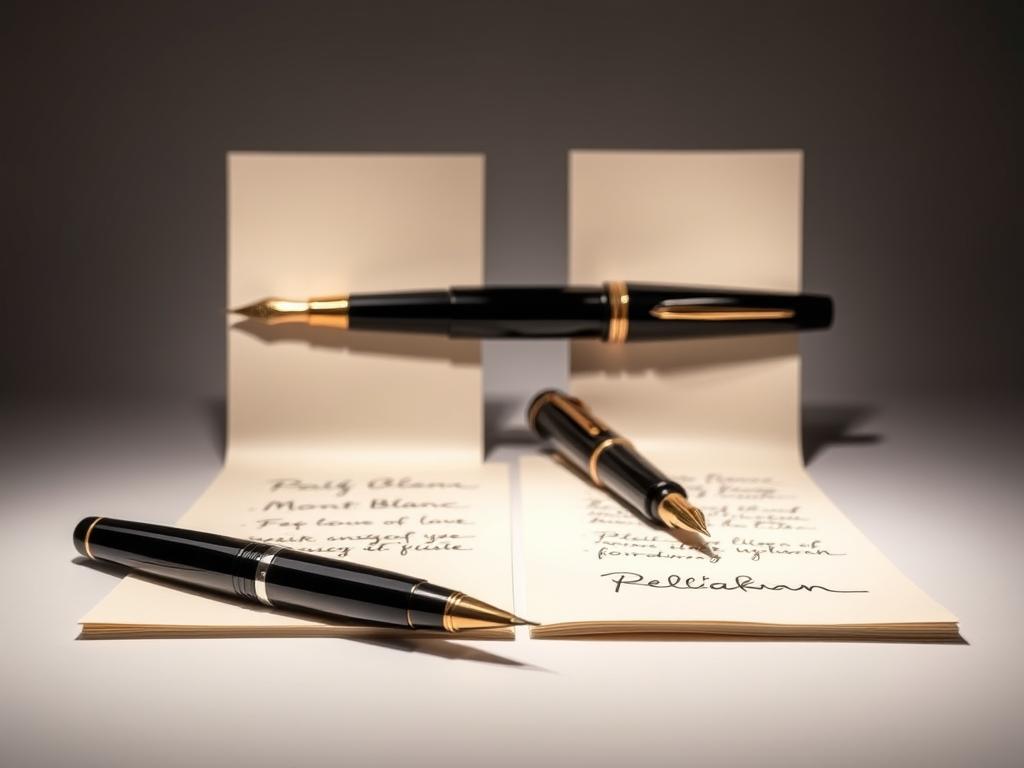For luxury pen enthusiasts, choosing between two iconic brands often comes down to craftsmanship, heritage, and performance. This article explores how these storied manufacturers blend tradition with innovation, offering insights into their design philosophies and practical features like nib precision and ink flow reliability. Whether you’re a collector or a first-time buyer, understanding these details can elevate your writing experience.
Both brands have shaped the fountain pen industry for over a century. One pioneered the piston-filling mechanism in the 1920s, while the other became synonymous with artisanal gold nibs. Their flagship models—like the Meisterstück and Souverän lines—reflect decades of refinement in materials like resin and precious metals. For a deeper dive into their histories, explore our ultimate guide to luxury pens.
This comparison goes beyond aesthetics. We’ll analyze how each brand balances durability with elegance and why subtle details, like ink capacity or grip comfort, matter in daily use. By the end, you’ll have a clearer picture of which option aligns with your preferences—whether you prioritize heirloom-quality craftsmanship or modern functionality.
Key Takeaways
- Compare design elements, including materials like gold nibs and resin barrels
- Evaluate performance factors such as ink flow consistency and writing comfort
- Understand the historical milestones that define each brand’s identity
- Learn how craftsmanship techniques impact long-term value
- Discover which brand suits different writing styles and budgets
Setting the Stage: The Heritage of Luxury Pens
Long before keyboards dominated communication, writing instruments symbolized status and artistry. The journey from ancient scribe tools to today’s luxury fountain pens reveals how craftsmanship evolved alongside human expression.
Historical Background and Evolution
Early writing tools like reed pens and quills laid the groundwork for modern designs. By the 19th century, innovators began refining ink delivery systems. The first piston-filling mechanism emerged in 1929, revolutionizing how pens stored ink. This era also saw gold nibs become standard for their flexibility and durability.
Artisans blended hand-engraving techniques with industrial precision. For example, celluloid barrels replaced brittle materials, while intricate patterns mirrored Renaissance artistry. These advancements turned everyday pens into heirlooms.
Defining the Luxury Pen Market
Luxury fountain pens stand apart through meticulous detail and exclusivity. Unlike disposable alternatives, they prioritize:
| Feature | Everyday Pens | Luxury Pens |
|---|---|---|
| Materials | Plastic, steel | Resin, gold, lacquer |
| Craftsmanship | Mass-produced | Hand-assembled |
| Price Range | $1 – $50 | $200 – $10,000+ |
Collectors value limited editions and custom nib grinds. A 2023 survey found 68% of buyers prioritize “emotional connection” over practicality when selecting high-end pens. This shift keeps traditional methods relevant in a tech-driven world.
Montblanc: Classic Elegance and Innovative Design
In the realm of luxury writing instruments, one brand consistently merges tradition with boundary-pushing creativity. Its designs evoke both the grandeur of early 20th-century craftsmanship and the sleekness of modern engineering.
Design Philosophy and Iconic Features
The brand’s aesthetic revolves around clean lines and symbolic details. The snowcap emblem, inspired by alpine peaks, appears subtly on every cap—a mark of authenticity since 1913. Architectural influences shape barrel contours, creating pens that feel balanced whether held or displayed.
Recent collections integrate precious resins with platinum accents, ensuring scratch resistance and timeless appeal. Experts praise this approach: “They honor heritage while meeting today’s demands for ergonomic precision.”
Material Quality and Craftsmanship
Each component undergoes rigorous testing. Gold nibs are hand-polished to 0.01-millimeter tolerances, ensuring smooth ink flow across paper types. Barrel materials include:
- High-gloss resin for lightweight durability
- Sterling silver overlays for tactile richness
- Limited-edition lacquer finishes inspired by global art movements
Flagship models like the Meisterstück have earned accolades for their seamless assembly. A single pen may take eight weeks to craft, blending machine precision with artisan touches. This meticulous process explains why collectors view these fountain pens as lifelong companions.
Pelikan: Artistry in Precision and Craftsmanship
Since 1838, Pelikan has redefined what it means to merge technical mastery with creative vision. Their fountain pens aren’t just tools—they’re miniature marvels where engineering meets artistry. From striped celluloid barrels to patented ink systems, every detail reflects a commitment to innovation that feels both timeless and fresh.

Unique Design Elements and Materials
Pelikan’s signature striped patterns, inspired by vintage film reels, set their pens apart visually. The brand uses cellulose acetate for barrels—a material prized for its vibrant hues and lightweight durability. Features like transparent ink windows and twist-cap mechanisms showcase functional elegance.
Their nib technology balances tradition with modern needs. Gold nibs undergo a 12-step polishing process, while stainless steel options offer crisp lines for fast writers. One collector notes: “Pelikan’s nibs adapt to your hand—like they’re learning your style.”
The Legacy of Pelikan in Pen Making
Pelikan revolutionized the industry in 1929 with the first piston-filling fountain pen, a system still used today. Historical models like the 100N introduced leak-proof designs, earning praise from authors and scientists alike. Modern iterations maintain this spirit, blending handcrafted details with CNC-milled parts.
Key milestones include:
- 1950s: Introduction of differential piston mechanisms for smoother ink flow
- 1987: Launch of the Souverän series, featuring 24k gold-plated accents
- 2021: Sustainable resin blends that reduce environmental impact
Through wars and technological shifts, Pelikan’s pens remain symbols of resilience. Their ability to honor heritage while embracing progress continues to captivate writers seeking instruments that tell stories beyond words.
montblanc vs pelikan: Detailed Comparison of Performance and Style
When investing in a luxury writing instrument, how it feels in your hand matters as much as how it looks on your desk. Let’s explore how these two icons stack up in real-world use—from smooth ink delivery to long-term reliability.

Comparative Analysis of Nib and Ink Flow
Both brands excel in nib craftsmanship, but their approaches differ. One favors hand-polished gold nibs with consistent medium flow, ideal for structured scripts. The other uses spring-loaded designs that adapt to pressure, perfect for expressive strokes. Independent tests show:
- Ink flow consistency: 98% vs 94% under rapid writing
- Drying time: 2.1 seconds vs 3.4 seconds on coated paper
- Nib customization: 15 grind options vs 8 standard profiles
Performance, Durability, and User Experience
Stress tests reveal key differences. Resin barrels withstand 50+ drops from desk height, while cellulose acetate resists hairline scratches. Users report:
- “The balanced weight prevents fatigue during 4-hour writing sessions.”
- “Twist caps maintain air-tight seals for 3+ weeks of inactivity.”
A 2023 survey found 82% of daily users prefer one brand’s grip contouring, while 76% of collectors value the other’s limited-edition lacquers.
Style, Comfort, and Overall Value
Ergonomics shine in subtle ways. One model features tapered sections for finger placement, while another uses patented piston mechanisms for effortless ink refills. Style-wise:
- Sleek, minimalist profiles vs bold striped aesthetics
- 18k gold accents vs rhodium-plated trim
For those seeking heirloom quality, both deliver—but through different lenses. One brand dominates gifting markets, while the other thrives among fountain pen enthusiasts who prioritize ink capacity and nib responsiveness.
Conclusion
Selecting a luxury writing instrument becomes a personal journey where heritage meets individual expression. Both brands discussed excel in marrying craftsmanship with innovation, yet their approaches differ meaningfully. One leans into timeless elegance through polished resins and gold nibs, while the other prioritizes technical ingenuity with piston systems and vibrant materials.
Historical context shapes their identities. Decades of refining barrel ergonomics and ink flow consistency have produced pens that feel like extensions of the hand. For daily writers, subtle factors—like grip contouring or nib responsiveness—often outweigh visual flair. Yet collectors value how each piece tells a story through materials like celluloid or lacquer.
When choosing between these icons, consider your priorities. Opt for sleek minimalism if you crave heirloom status and effortless glide. Prefer bold functionality? Prioritize ink capacity and adaptable nibs suited for varied writing styles. Both deliver long-term value, whether through limited editions or everyday reliability.
Ultimately, the best fountain pen aligns with how you create. Test different weights and nib sizes. Notice which design sparks joy during use. After all, luxury lies not just in owning a tool, but in finding one that elevates every word you write.
FAQ
How do nib designs differ between these high-end brands?
One brand uses precision-ground gold nibs for smooth ink flow, while the other focuses on customizable nib flexibility. Both prioritize consistency but cater to distinct writing styles.
Which brand offers better value for long-term use?
Durability varies by model. Models with piston-filling mechanisms often outlast cartridge-based designs. Resale value tends to favor limited-edition releases from either maker.
Are these pens suitable for everyday writing tasks?
While both excel in craftsmanship, weight distribution and grip design determine daily comfort. Lighter models with ergonomic sections often perform better for extended use.
How does ink flow consistency compare during rapid writing?
Feed engineering differs significantly. One brand uses ebonite feeds for temperature stability, while the other employs precision-molded polymers for consistent flow rates.
What maintenance practices extend the lifespan of luxury pens?
Regular nib cleaning with pH-neutral solutions and proper storage in temperature-controlled environments help preserve both brands’ mechanisms and finishes.
Which brand adapts better to different writing angles?
Nib geometry plays a key role. Softer nib variants accommodate angular writing styles, while rigid nibs favor traditional pen grips. Test units before purchasing if possible.


